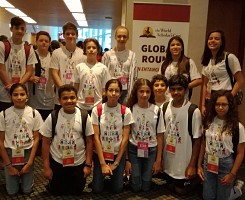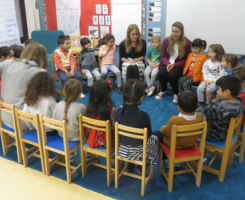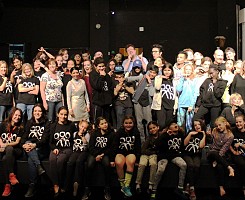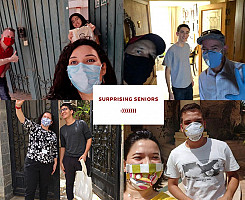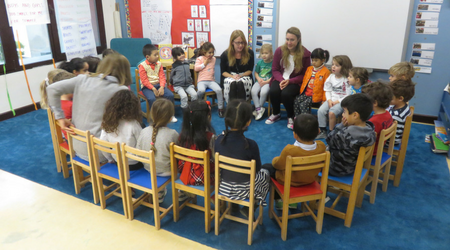 CAC emphasizes holistic student development by teaching social and emotional literacy in the classroom. One way we do this is by integrating discussions of the CAC Core Values into lessons and activities. When elementary principal Julie Jackson-Jin came to CAC in 2012, she brought with her another unique teaching tool called Circle Solutions for Student Wellbeing.
CAC emphasizes holistic student development by teaching social and emotional literacy in the classroom. One way we do this is by integrating discussions of the CAC Core Values into lessons and activities. When elementary principal Julie Jackson-Jin came to CAC in 2012, she brought with her another unique teaching tool called Circle Solutions for Student Wellbeing.
Developed by psychologist and educator Sue Roffey, Circles is a method for fostering relationship-building skills in the classroom. This year, CAC Elementary invested in the longevity of the program by having school counselor Dana Purpura and teachers Bonnie Greene, Trillian Clifford, and LeeAnn Kasel trained as Circles facilitators. The group then led a training for all other elementary teachers.
Clifford explained how a Circles session works: “It’s kind of like a meeting time where we all come together in a circle and all students and adults participate. There’s a greeting, we mix up and sit in different places, and there’s always a fun game we play together to get to know each other.”
Not every Circles session is the same, though, and teachers can change up the game and discussion to address different aspects of building relationships. Oftentimes teachers lead Circles sessions focused on CAC Core Values. One of Clifford’s favorite exercises is based on the book Have You Filled a Bucket Today? by Carol McCloud. She explained, “the idea is that everyone has this imaginary bucket that can be emptied by people doing less kind things to you or filled by people doing kinder things to you.”
In the activity, students decorate droplets of water to fill their buckets by drawing examples of kindness. They return to the circle and share these drawings with one another. “They’re really excited to share their bucket droplets with the class,” Clifford reflected. “Every single day in class, they talk about how ‘someone filled my bucket today’ or ‘I want to fill up your bucket.’ The activity really resonates with them.”
A key value of Circles Solutions is that it creates a safe space where students can understand one another on an individual level, bridging cross-cultural differences and creating a closer classroom community. Purpura explained that “Circles promotes getting to know people [individually] and learning how to appreciate differences. I think it really helps with breaking down walls because students are learning about each other and realizing similarities in feelings or differences they might have.”
Circles’ popularity in CAC classrooms is also likely because it is fun. Greene reflected, “CAC is academically rigorous, and this is a little time to relax, have a laugh, and have some fun. At the same time, we can weave in learning opportunities and teach emotional literacy.”
CAC emphasizes holistic student development by teaching social and emotional literacy in the classroom. One way we do this is by integrating discussions of the CAC Core Values into lessons and activities. When elementary principal Julie Jackson-Jin came to CAC in 2012, she brought with her another unique teaching tool called Circle Solutions for Student Wellbeing.
Developed by psychologist and educator Sue Roffey, Circles is a method for fostering relationship-building skills in the classroom. This year, CAC Elementary invested in the longevity of the program by having school counselor Dana Purpura and teachers Bonnie Greene, Trillian Clifford, and LeeAnn Kasel trained as Circles facilitators. The group then led a training for all other elementary teachers.
Clifford explained how a Circles session works: “It’s kind of like a meeting time where we all come together in a circle and all students and adults participate. There’s a greeting, we mix up and sit in different places, and there’s always a fun game we play together to get to know each other.”
Not every Circles session is the same, though, and teachers can change up the game and discussion to address different aspects of building relationships. Oftentimes teachers lead Circles sessions focused on CAC Core Values. One of Clifford’s favorite exercises is based on the book Have You Filled a Bucket Today? by Carol McCloud. She explained, “the idea is that everyone has this imaginary bucket that can be emptied by people doing less kind things to you or filled by people doing kinder things to you.”
In the activity, students decorate droplets of water to fill their buckets by drawing examples of kindness. They return to the circle and share these drawings with one another. “They’re really excited to share their bucket droplets with the class,” Clifford reflected. “Every single day in class, they talk about how ‘someone filled my bucket today’ or ‘I want to fill up your bucket.’ The activity really resonates with them.”
A key value of Circles Solutions is that it creates a safe space where students can understand one another on an individual level, bridging cross-cultural differences and creating a closer classroom community. Purpura explained that “Circles promotes getting to know people [individually] and learning how to appreciate differences. I think it really helps with breaking down walls because students are learning about each other and realizing similarities in feelings or differences they might have.”
Circles’ popularity in CAC classrooms is also likely because it is fun. Greene reflected, “CAC is academically rigorous, and this is a little time to relax, have a laugh, and have some fun. At the same time, we can weave in learning opportunities and teach emotional literacy.”



